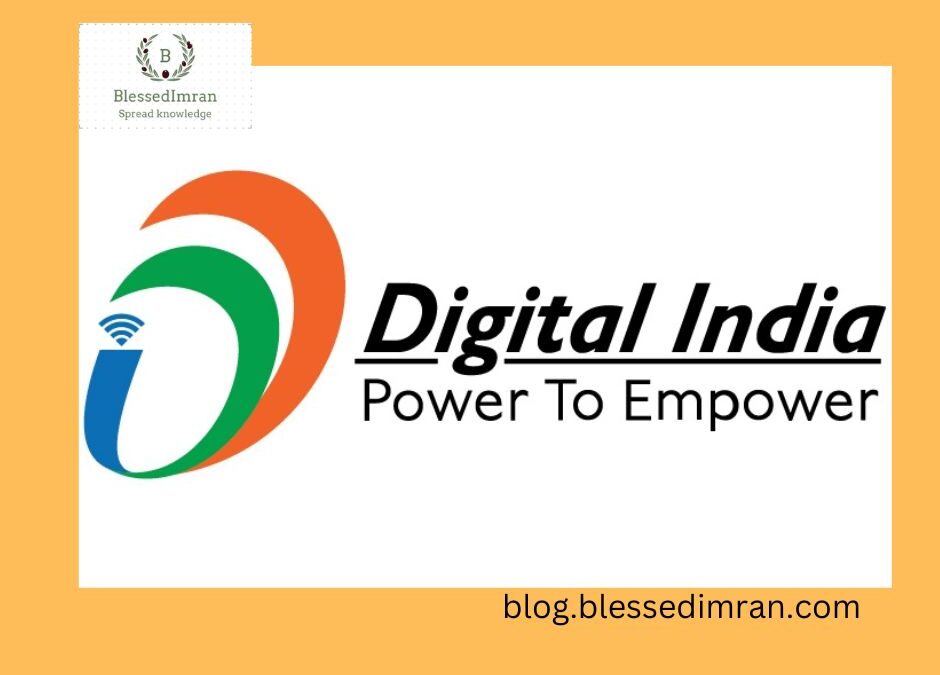INTRODUCTION
In order to transform the entire ecosystem of public services through the use of information technology the government of India has launched the digital India program.It was basically launched with the vision to transform India into a digitally empowered society and knowledge economy as a whole.
Digital India Mission was launched by PM Narendra Modi on 1st July 2015.It was launched as a beneficiary to other government schemes including Make in India, Bharatmala, Sagarmala, Startup India, BharatNet, and Standup India.

The digital India program is centred on the key vision areas as follows:-
1. Digital infrastructure as a core utility to every citizen
2.Governance as well as services on demand
3.Overall digital empowerment of citizens.
Digital infrastructure as the utility to every citizen:-
1.Availability of high speed internet as a core utility for the delivery of services to citizens
2. Cradle to Grave digital identity that is unique, lifelong, online as well as authenticable to every citizen.
3.Not only mobile phone but also bank account enabling citizen participation in digital and financial space.
4.Easy access to a CSC( Common Service Center)
5.Shareable private space on a public cloud
6.Safe as well as Secure cyber space
Governance and services on demand
-Seamlessly integrated services across departments or jurisdictions
-Availability of services in real time from both online and mobile platforms
-All citizens entitlements to be both portable and available on the cloud
-Digitally transformed services for improving ease of doing business
-Making financial transactions both electronic and cashless
-Leveraging overall Geospatial Information Systems(GIS)for decision support systems and development
Digital Empowerment of citizens:-
Overall universal digital literacy
Universal accessible digital resources
Availability of digital resources/services in Indian languages
Collaborative digital platforms for participating governance
Citizens not required to physically Submit government
documents/certificates
Digital Rural India
The Government’s ambitious 1.3 lakh crore Digital India scheme aims to bridge the rural -urban gap and bring internet to the masses.
The vision of digital India is centered around three key areas
1.Digital infrastructure as a utility to every citizen
2.Governance and Services on demand
3.Digital employment of citizens
Digital India programmes’ direct benefit to farmers
The EPF member or beneficiary of the pension has to submit life certificate in November of every year to certify that he/she is alive. This form has to be to the branch manager of the bank by the individual with active pension account detail.
Merger of 3 ongoing programmes:
1. National Optical Fibre network(NOFN)
2. National Knowledge Network
3. e-Governance initiative
Objectives
*Transform India into digital empowered society and knowledge economy *Increased availability of electronic government services to citizens
*Wipeout digital divide and offer digital solutions in almost all sectors like
education, health, agriculture, and administration

NINE PILLARS:-
1.Broadband highways: Connecting Panchayat through broadband and provide SWAN and NOFN in urban areas.
2.Universal access to phones:Pan-India mobile connectivity especially in remotest places. Increasing spectrum will support growing mobile penetrations.
3.Public internet access:Public internet access through CSC and post offices in gram panchayats, where all government schemes would be accessible.
4.e-Governance:Reforming government through technology bringing government to doorsteps of citizen through online applications, simple forms, electronic data bases etc.
5.e- Kranti:Electronic delivery of service comprises 41 large e-Governance initiative called MMPs which include e-education, e-healthcare, security and technology for cyber security.
6.Information for All: Two way communication channel to access information and provide feedback.For example My Gov.in, social media use to reach out to citizens(Twitter).
7.Electronic Manufacturing: It boosts electronics manufacturing through incentives support to incubators,increased skill development,more local procurement, etc.Target net zero imports by 2020 that is imports =Exports.
8.IT for jobs:To train 1 crore students from small towns and villages for IT sector jobs in 5 years .
9.Early harvest programs:Simple initiative to enable prompt digitalisation of services like biometric attendance in government organisations, Wi-Fi in universities, ebooks, SMS based weather reports etc.

Advantages of Digital India
1.Electronic transactions related to e-governance has increased consequently after this initiative .
2.The urban internet penetration has reached 64% and internet data is used
as an overall major tool for the delivery of the services.
3.Digital vilages along with well equipped facilities such as solar lighting, LED
assembly unit, sanitary napkin production unit as well as Wi Fi choupal has been
established as a part of this initiative.
4.Under the Bharat Net Programme an optical fibre network of 274246 Km
has connected over 1.15Lakhs Gram Panchayats.
5.Under the National e-Governance Project of the Indian government a
Common Service Cener (CSC) is created which provides access for
information and communication technology(ICT).The CSC s provide
multimedia content related to e- governance , education , health,
telemedicine,entertainment and other government and private services
through computer and internet services.
Challenges of Digital India:-
1. Compared to other developed nation the internet speed and Wi Fi hotspot are slow.
2.Lack of user awareness as well as knowledge.
3.To look for about one million cybersecurity experts particularly to check and monitor the growing menace of digital crime.
4.Lack of skilled manpower specifically in the field of digital technology.
5.Limited capability of entry-level smartphones for overall smooth internet access.
6.Most of the small as well as medium scale industry has to struggle a lot for adapting to the new modern technology.
Conclusion:-
Digital India is not only a good but also an appreciable initiative launched by Government of India to speed up the growth of India by connecting Rural areas by towns and cities. This scheme is promoted by Government basically to use maximum things in a digital way. The main objective of digital India is to reduce paperwork as well as connect every area of India with high-speed internet connectivity. This scheme, also gives good contribution in Growth of India.Though there are challenges in the way to Digital India, our Indian Government is having clear strategy to find a way and make it a successful programme.
An Individual may gather further information regarding Digital India from its official website i.e https://digitalindia.gov.in/
